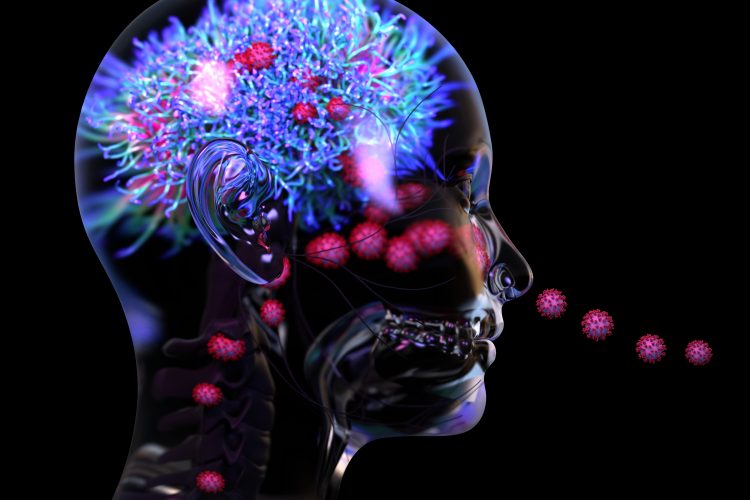Blood vessel damage likely causes neurological symptoms of COVID-19, finds study
Posted: 4 January 2021 | Hannah Balfour (Drug Target Review) | No comments yet
A new study suggests that inflammation and blood vessel damage may be the primary causes of neurological symptoms in COVID-19 patients, instead of the virus infecting the brain.


Researchers have shown that the neurological symptoms associated with COVID-19 are most likely a result of blood vessel damage caused by the immune response and not the SARS-CoV-2 virus (which causes COVID-19) directly infecting and attacking the brain.
Results from the study of how COVID-19 affects a patient’s brain were published as a correspondence in the New England Journal of Medicine.
In their study, the researchers conducted high-resolution magnetic resonance imaging (MRI) and histopathological examination on the brains of patients that had died from COVID-19. In total they studied 19 brains and focused on identifying microvascular changes in the olfactory bulb and brainstem – two regions that are thought to be particularly susceptible to COVID-19. The patients died at a wide range of ages, from 5 to 73 years old, and many had one or more comorbidities, including diabetes, obesity and cardiovascular disease. There was also a range in how quickly donors died after reporting symptoms, from within a few hours to two months.
In the brains of those who died shortly after contracting COVID-19, the team found hallmarks of damage caused by thinning and leaky brain blood vessels.
“We found that the brains of patients who contract infection from SARS-CoV-2 may be susceptible to microvascular blood vessel damage. Our results suggest that this may be caused by the body’s inflammatory response to the virus,” said Dr Avindra Nath, clinical director at the National Institutes of Health (NIH)’s National Institute of Neurological Disorders and Stroke (NINDS), US, and the senior author of the study.
Although COVID-19 is primarily a respiratory disease, patients often experience neurological problems including headaches, delirium, cognitive dysfunction, dizziness, fatigue and loss of the sense of smell. The disease may also cause patients to suffer strokes and other neuropathologies. Multiple studies have shown that COVID-19 can cause inflammation and blood vessel damage, with one identifying small amounts of SARS-CoV-2 in some patients’ brains; however, we are still unsure how the disease affects the brain.
![In an in-depth study, NIH researchers consistently found blood vessel damage in the brains of COVID-19 patients but no signs of SARS-CoV-2 infections. Here is a high-resolution scan of a patient's brain stem. Arrows point to light and dark spots that are indicative of blood vessel damage observed in the study [Credit: Courtesy of NIH/NINDS].](https://drug.russellpublishing.co.uk/wp-content/uploads/COVID-19-Brain-blood-vessels-297x250.jpg)
![In an in-depth study, NIH researchers consistently found blood vessel damage in the brains of COVID-19 patients but no signs of SARS-CoV-2 infections. Here is a high-resolution scan of a patient's brain stem. Arrows point to light and dark spots that are indicative of blood vessel damage observed in the study [Credit: Courtesy of NIH/NINDS].](https://drug.russellpublishing.co.uk/wp-content/uploads/COVID-19-Brain-blood-vessels-297x250.jpg)
In an in-depth study, NIH researchers consistently found blood vessel damage in the brains of COVID-19 patients but no signs of SARS-CoV-2 infections. Here is a high-resolution scan of a patient’s brain stem. Arrows point to light and dark spots that are indicative of blood vessel damage observed in the study [Credit:
Courtesy of NIH/NINDS].
In this study, the researchers used a high-powered MRI scanner to examine samples of the olfactory bulbs and brainstems from each patient. These two regions are thought to be highly susceptible to COVID-19, because of some of the neurological symptoms associated with the disease: the olfactory bulb controls our sense of smell and therefore is thought to be linked to the loss of smell and taste; the brainstem controls our breathing and heart rate and therefore may be implicated in dizziness. The scans revealed that both regions had an abundance of bright spots – hyperintensities – which often indicate inflammation and dark spots – hypointensities – which represent bleeding.
Using their scans as a guide the team then examined these spots more closely under a microscope. They found that the bright spots contained blood vessels that were thinner than normal and sometimes leaking blood proteins, like fibrinogen, into the brain. Surrounding these hyperintensities were T cells, indicating an immune response. In contrast, the dark spots contained both clotted and leaky blood vessels but no immune response.
“We were completely surprised. Originally, we expected to see damage that is caused by a lack of oxygen. Instead, we saw multifocal areas of damage that is usually associated with strokes and neuroinflammatory diseases,” said Dr Nath.
Additionally, they were unable to detect SARS-CoV-2 or its genetic material in any of the tissues, leading them to suggest the damage was not caused by a direct viral attack on the brain. However, cautioned that this may be because the virus was cleared by the time of death or that viral copy numbers were below the level of detection by our assays.
Dr Nath concluded: “So far, our results suggest that the damage we saw may not have been not caused by the SARS-CoV-2 virus directly infecting the brain. In the future, we plan to study how COVID-19 harms the brain’s blood vessels and whether that produces some of the short- and long-term symptoms we see in patients.”
Related topics
Analysis, Analytical techniques, Disease research, Imaging, Microscopy, Neurosciences, t-cells
Related conditions
Coronavirus, Covid-19
Related organisations
National Institutes of Health (NIH), US National Institute of Neurological Disorders and Stroke (NINDS)
Related people
Dr Avindra Nath



